Giant Allege by ProfessorProf
Introduction
Original SA postquote:
Ground Judge.
In this land of untamed wilderness, since time immemorial, conflict has been resolved in the courts. The rules of court are simple: Justice to the victorious, and nothing else.
In order for the weak to also see justice, proxies can stand up for their clients in court. Thusly do people raise great sums of money to hire defense attorneys to claim justice for them. Defense attorneys with strength peerless throughout the land.
Why are the defense attorneys so strong? That's simple. Because they're piloting giant robots!

Giant Allege is, in its own words, a "Heart-Pounding Robot Courtroom RPG" from Japan, which boasts the following key points:
It doesn't require a GM or a scenario! The rules establish everything necessary for play, and the system has no particular need for a game master.
It doesn't require roleplaying! It certainly spices things up, but it can be played like a board game.
Everything is player VS player combat! Use your giant robot and battle skills to defeat the opposing players and get your way.
It might not actually be an RPG! As all the above suggests, it exists in a strange place in between RPGs and board games.
Each of the players controls a giant robot pilot slash lawyer in post-apocalyptic Australia, fighting to claim justice for their client. The last one standing gets the verdict they desire. The rulebook is distributed as a 28-page PDF, so hopefully this won't take too many entries to get through.
Next, I'll properly kick the book off with the setting chapter!
Post-Roboapocalyptic Australian Legal Deathmatch
Original SA post
Giant Allege part 2: Post-Roboapocalyptic Australian Legal Deathmatch
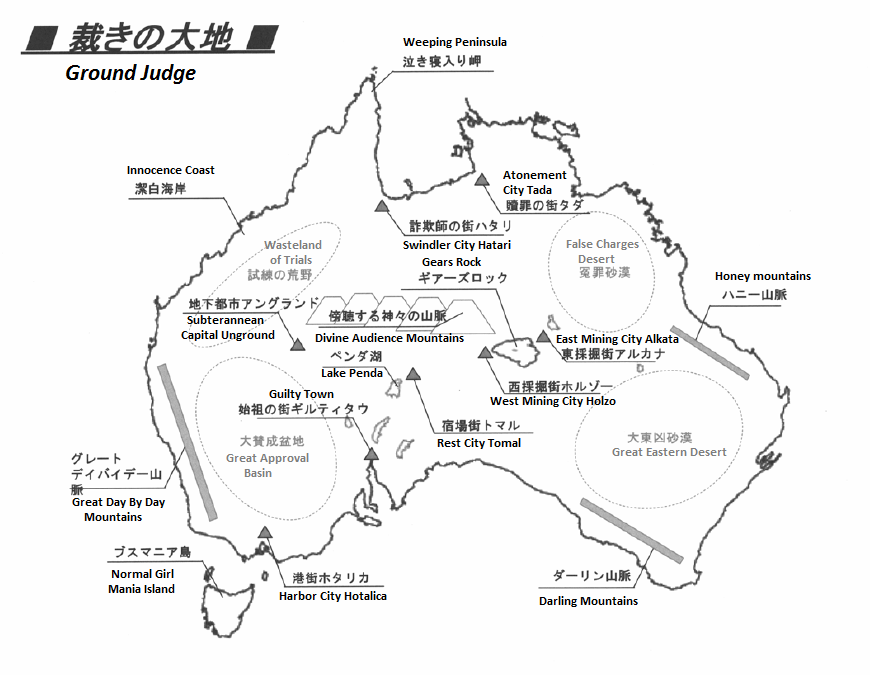
Place names liberally localized.
This is where the game takes place. It's never explicitly called Australia, but I mean, shit, look at it.
This chapter is dedicated to establishing the key aspects of the setting before we dive into the nitty gritty details.
Giant Allege is the name of the type of giant robot used by defense attorneys. They have the same movement range and speed of a human, except they're 9-30 meters tall and made of metal. They come in an endless variety of shapes and armaments. They are the most powerful weapons on Ground Judge.
Giant Alleges made during the previous era are manipulated via telepathic controls. Alleges made in the modern day are controlled via the "Marionette Control" system, which exactly mimics the motions of the pilot. A Giant Allege is activated by a special activation key in the form of an attorney's badge.
Controlling a Giant Allege requires abilities and reflexes far beyond that of regular humans, so Lawyers are usually the best of the best of humanity. There are even some rare cases of Lawyers becoming more powerful than their Giant Allege.
To become a Lawyer, one must travel to the Divine Audience Mountains and seek the Tower of Deliberation, where they will face a mighty trial known as a Legal Examination. If they are triumphant, they will be granted an Attorney's Badge. The areas tested in the Legal Examination are swordsmanship, Giant Allege piloting, and defensive ability, all held to extremely high standards - less than one percent of challengers pass the test. Once the Examination is cleared, the new Lawyer must climb Gears Rock to receive their Giant Allege and begin making a name for themself as a Lawyer.
Judgment is the term for the battles fought in the name of justice on Ground Judge. When there is a dispute between people, it is resolved by a brutal battle to be the last man standing. If someone is weak, but has a strong need of justice, then they can hire a Lawyer to fight in their place with a giant robot.
Judgment Satellites are the silent guardians of Ground Judge, looking down from the heavens since a lost age thousands of years ago. From the surface, a call of "Frugativi et Appelavi" is made to the heavens, and one of the Judgment Satellites will shine a light down on the place that will be the battlefield of Judgment. One week later, the Giant Allege will meet there for a decisive battle to claim their wanted verdict.
Ground Judge is the name of the suspiciously Australia-like continent on which the game takes place. Until 500 years ago, countless criminals were sent here, but now it has been cut off from the outside world by an impassable barrier of wind called the Nonaggression Wind Wall. A cruel land, where power is justice. With a hot and dry climate, the inhabitants manage a grueling survival.
Gears Rock is an enormous rock in the center of the continent, 20 kilometers long. Countless Giant Allege slumber atop it.
The next section of the book is on the economy and culture of Ground Judge, which are similar to America's Wild West (or at least how it's remembered in modern popular culture). Guns and airplanes exist. Alcohol runs free, and the blood of the guilty flows thick. Many conflicts are simply resolved by force between the involved parties, but if a conflict gets too big, then it is settled by Giant Allege. Next, we get some quick descriptions of some of the cities on the map:
Western Mining Cities Holzo and Eastern Mining Town Alkata : Two mining communities on opposite ends of Gears Rock. Primary exports are copper.
Rest City Tomal : A connection point between Gears Rock and Guilty Town.
Subterannean Capital Unground : A massive Geofront made to escape the heat of the surface, and the capital of Ground Judge. A popular living place for the fabulously wealthy.
Port City Hotalica : Harbor city with a thriving fishing trade. The go-to place on Ground Judge for goods from the sea.
Atonement City Tada : Those found guilty in Judgments are sent here.
Swindler City Hatari : A ruthless city where Judgment fraud runs rampant. As long as you win, even fraud can become justice.
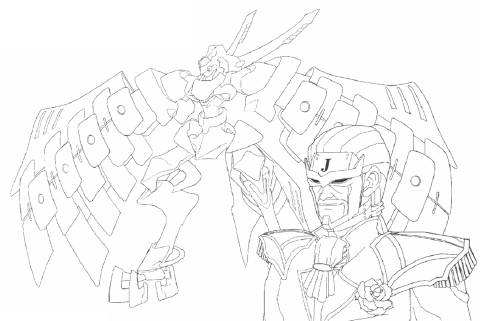
This is the book's only real fleshed-out NPC, Prosecutor J , and his noble steed, Justice The Giant Allege . J is a humanoid android sent to Ground Judge from the Judgment Satellites whenever there is a disruption in a trial of Judgment.
All of the setting information in the book is delightfully incoherent and full of unanswered questions. Next, I'll get into some of the actual game mechanics.
Wheel of Morality, Turn Turn Turn
Original SA post
Giant Allege, Chapter 3: Wheel of Morality, Turn Turn Turn
So, mechanics!
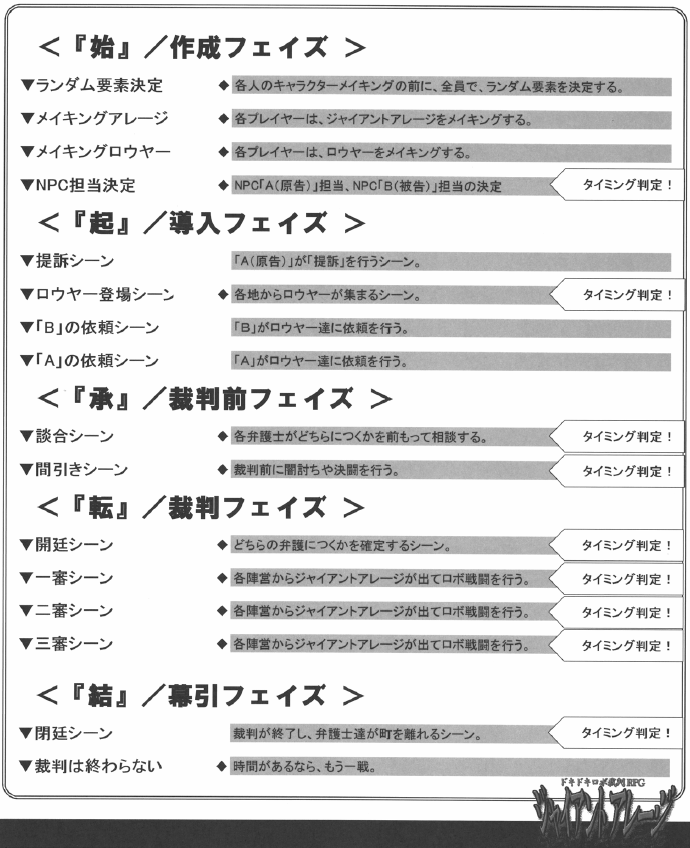
This is something I've seen a couple Japanese RPGs do that I'm fond of - lay out the typical flow of a session from start to finish in a sort of cheat sheet. Approximately:
Prologue / Creation Phase
Random Aspect Generation: Before each person makes their characters, everyone determines random settings.
Make Allege: Each player creates their Giant Allege.
Make Lawyers: Each player creates their Lawyer.
NPC Role Determination: NPC A (The plaintiff) and NPC B (the accused) roles determined (determine timing!)
Act 1 / Introduction Phase
Case Presentation Scene: NPC A presents their case to those gathered.
Lawyer Arrival Scene: Scene where all the lawyers arrive at the battlefield. (determine timing!)
B's Request Scene: NPC B makes their request to the lawyers.
A's Request Scene: NPC A makes their request to the lawyers.
Act 2 / Pre-Judgment Phase
Debate Scene: Attorneys discuss the points of each side. (determine timing!)
Culling Scene: Before the Judgment, resolve surprise attacks. (determine timing!)
Act 3 / Judgment Phase
Trial Scene: Each attorney determines which side they will fight for.
First Hearing Scene: Each side deploys in their Giant Allege and do battle.
Second Scene: Each side deploys in their Giant Allege and do battle.
Third Scene: Each side deploys in their Giant Allege and do battle.
Act 4 / Resolution Phase
Closing Scene: Judgment ends, and the lawyers go their separate ways.
The Judgment Never Ends: When the time comes, there will be another battle.
That's the general structure of a session of Giant Allege. For now, let's focus on the Prologue!
Like nearly every Japanese RPG ever made, Giant Allege is both entirely d6-based and involves huge random generation tables. We kick things off with a random chart to determine who our NPCs our, and what they want. This takes the form "By A's request, the trial of A vs B, on the subject of the D of C." A, B, and C are each rolled on a huge 6x6 table, whereas D only has six options. Let's break it down:
code:
Roll A/B C
11 Villager The mines
12 Son Water
13 Parent Town
14 Brother Forest
15 Child Railroad
16 Old person Money
21 Young person Land
22 Mayor Medicine
23 Scientist Children
24 Bakery Roads
25 Farmer Estate
26 Factory Worker Home
31 Bank Castle
32 Mechanic Workplace
33 Politician Store
34 Village leader Heirloom
35 Nouveau Riche Weapons
36 Mafia Ship
41 Noble Inheritance
42 Outsider Time
43 Laborer Life
44 Betrothed Heart
45 Fiancee Food
46 Secret lover Work
51 Physician Alcohol
52 Doctor Right Arm
53 Merchant Family
54 Courier Ruins
55 Chef Lake
56 Wife Plaza
61 Husband Education
62 Deceased Harbor
63 Actor Political power
64 Artisan Grave
65 Father Power Plant
66 Swindler Water Plant
code:
Roll D
1-3 Rights/Possession
4 Duties
5 Incident Culprit
6 Law, Contract
A: Scientist
B: Wife
C: Incident Culprit
D: Harbor
The book explicitly advises changing the results if your group can't come up with a good story, but that won't be necessary here. Since there's no way a scientist in this setting isn't Mad, this is clearly a case of the scientist accusing his wife of stealing his doomsday device and firing it into the harbor, killing thousands of fish and disrupting local fishing on a massive scale.
Following this, we determine the 'Budget' for each side. For side A (The mad scientist) and side B (his harbot-obliterating wife), we roll one die per player, and multiply the result by four to determine the Budget. Whichever side has less budget is now designated the Good side, and the higher is designated the Evil side. In our case, I'm doing a 2-player scenario, so I roll 2d6x4 for each side - I rolled a 7 and a 6, so Team Scientist has a budget of 28 and Team Wife has a budget of 24. Since the Wife has been designated as the Good side, presumably she fired the doomsday device into the harbor in order to keep her husband from firing it into an orphanage.
Next step is Making Allege! In true JTTRPG fashion, this is done almost entirely by rolling on random tables. There's one for Chassis and one for Equipment - by default, each Allege gets two pieces of equipment, but some chassis might change the number. Starting at this point, and ending at the Lawyer Introduction scene, each player should keep their chargen details secret from the other players.
Once the random parts have been taken care of, you determine your Allege's attributes:
Quick - determines the Allege's speed and maneuverability.
Break - determines the Allege's power and attack damage.
Armor - determines the Allege's durability and size.
Followed by your Lawyer's name, weapons, and attributes:
Timing - includes luck, and determines turn order within a scene.
Power - the Lawyer's physical strength and toughness. Because of the Marionette Control System, this affects the physical strength of your Allege.
Keen - speed and physical skill. Determines handling in your Allege.
Distribute 10 points between these three, with a minimum of 1. Details of chargen come later in the book, so this is all kept pretty high-level for now.
That brings us to the end of the high-level explanation of the Prologue. To tide us over until we reach the actual game mechanics, here's Prosecutor J's completed character sheet:
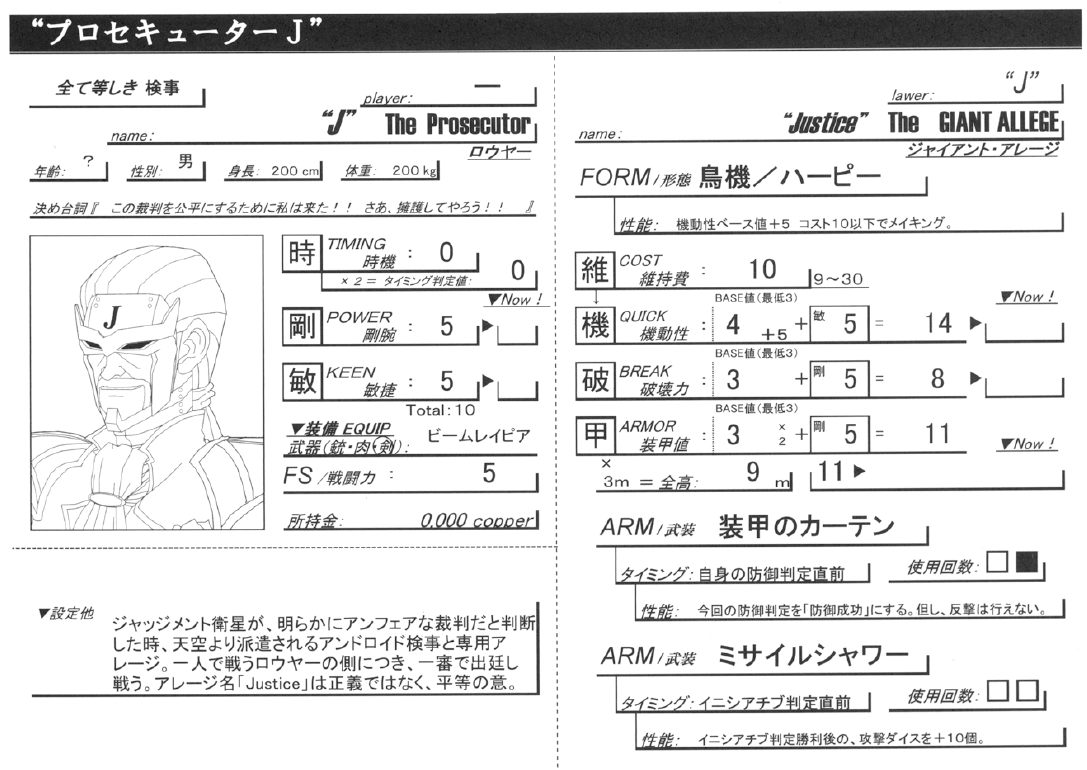
Next time: High-level overview of the remaining four acts.
Go ahead and get the Ace Attorney jokes out of your system now
Original SA post
Giant Allege Part 4: Go ahead and get the Ace Attorney jokes out of your system now
Act 1 Overview: Introduction Phase
Case Presentation Scene
The players in charge of side A make their dramatic call to the Judgment Satellites in the place of their client. Responding to their call, the Judgment Satellites send down a beam of light, and one week later, the concerned parties and their mighty lawyers assemble at the point where the light strikes the ground.
Lawyer Introduction Scene
Roll initiative (to be explained later), and in order of success, each lawyer arrives at the scene. A pure roleplaying scene where the players each in turn introduce their lawyer and their allege as they arrive on the field of judgment.
B's Request Scene/A's Request Scene
In front of the gathered lawyers, B (the accused) explains their situation and their request. B summarizes their key points about the case. There is a question and answer session, and then B leaves, and the whole thing is done again with A.
Act 2 Overview: Pre-Judgment Phase
Rig the Bids
After a brief debate, each Lawyer declares, in initiative order, which client they're going to represent, and move out to their respective sides. The rules specifically call out that this is a verbal promise, but is not more binding than that, conveniently allowing for mid-battle betrayals.
Thin Out
Before Judgment proper begins, there is an opportunity to try and take out enemy lawyers early using surprise attacks. In initiative order, each Lawyer declares whether or not thety wish to make a surprise attack, and against who. They engage in a one-turn battle (conflict resolution rules later), and whether or not the battle is resolved, it ends there. The winner of a surprise attack battle can either reduce the loser's highest attribute by one, force the loser to join a specific camp, or swap Giant Alleges with the other Lawyer which sounds like it has hilarious potential.
Act 3 Overview: Judgment Phase
Open the Court
The Lawyers enter the battlefield in this order:
The lawyer of the player controlling NPC A
The lawyer of the player controlling NPC B
Lawyers who were forced into a camp during Thin Out
Remaining Lawyers in Initiative order
If, after all this, either camp (A or B) has only one player, then Prosecutor J joins the battle on their side, controlled by that player.
First Judgment
In initiative order, regardless of camp, each Lawyer now chooses whether or not to deploy their Allege. If they do, then the Cost stat for their Allege is subtracted from their client's Budget (there it is!). If the client doesn't have enough Budget left to pay the Allege's Cost, then they'll have to go toe to toe with the enemy Allege on foot. Don't worry, Lawyers can do that.
Here is where the battle between Lawyers rages. Robots rise and fall. More on this bit later, but those defeated can no longer participate in the session.
Deliver Judgment
As narrated by the player controlling the winning NPC:
Thunderous voice from the heavenly Judgment Satellites posted:
We shall now pass judgment. This court finds (A/B) victorious, and we acknowledge their request.
Petition Appeal
If the losing camp has any Lawyers left who can still fight, then the battle is not over. With a shout of "Objection!" , they may begin a second round of combat with the remaining Lawyers on both sides. If anyone wants to deploy Allege in this scene, they need to pay Cost again out of their client's Budget. If, after this battle, there are still Lawyers standing on both sides, a THIRD round can be fought.
Act 4 Overview: Resolution Phase
Dismiss the Court
Unspent Budget is split between the remaining victorious lawyers. Everyone gives their exit scene, in initiative order. All lawyers increase one stat by one point, and leave the battle.
Never-ending Judgment
If you still have time in your evening at this point, you can continue on with the same lawyers into another Judgment. All damage is repaired, people can make new Lawyers or Giant Allege, basically whatever. For as long as Ground Judge stands, there will be need for more ridiculous legal mecha battles.
Next: Chargen!
(Incidentally, I made a couple revisions to my last entry , clarifying some stuff I either didn't understand or had wrong.)
Invincible Attorney Textbook Adulterer
Original SA post
Giant Allege Part 5: Invincible Attorney Textbook Adulterer
Character creation! First Allege, then Lawyer.
Making Allege
An Allege consists of a Form, a set of Armaments, a Cost, and a set of Attributes. The Form is the overall shape of the mech, of which there are several - swordsmen, tanks, animals, and so on, predictably rolled on a bigass table. Roll, record characteristics, done.
Armaments are weapons or other useful addon systems for your Allege. There is an equally wide variety of these, once again on a bigass table. Unless the Form has a relevant special ability, you get two Armaments, so roll them on the big table and add them to your mech.
Cost is, as described in the previous entry, how much Copper (which I guess is the currency, I wrote it before as Kappa WHOOPS) it costs to deploy your Allege. Depending on the power of the Allege, in terms of Attributes, the Cost will generally vary between 9 and 30, each point of Cost representing 10,000 Copper. A higher-Cost Allege will be more powerful, but also harder to deploy.
Attributes, mentioned earlier in the writeup, are Quick (speed and agility), Break (attack power), and Armor (defense power). You can distribute points any way you want between them, and the sum of the stats becomes your Cost. Unless the Form says otherwise, minimum in each Attribute is 3. Armor*3m is the height of your mech, not that it's at all important.
But these are just your base stats! Write them down, and then write the full stats to the right of them, which are modified by your Lawyer's stats:
Full Quick = Quick + Keen
Full Break = Break + Power
Full Armor = 2*Armor + Power
Finally, consider the image of the Form, Armaments, and size, and give it a name to match.
Making Lawyer
A Lawyer needs a Name, Attributes, a Weapon, a Catchphrase, and a few other details. Name is, insanely enough, ALSO rolled off of a 6x6 table, once for last name and once for first name. I'm not going to get into the full tables until much later, but rolling a pair of names just now, I got Wandering Iron Wall and Textbook Adulterer , so I can already tell these are going to be some colorful characters.
Next up is attributes for Lawyers! They are Timing (Initiative), Power (Strength and toughness), and Keen (Speed and piloting skill), between which 10 points are distributed (minimum 1). A typical human would be 2's across the board. You are not an ordinary human. You are a Lawyer.
Next, it's time to pick a weapon. There are three options:
Gun: Attack rolls made at Timing x 2.
Sword: Attack rolls made at Keen + Timing.
Fist: Attack rolls made at Power + Timing.
Pick one, write down the resulting attack power, go.
Next, come up with an age, a body type, and a personality, then tie it all together into a cohesive image. Consider the name, the Allege, the weapon, and the stats, and then come up with a one-liner catchphrase to sum up your character.
Since this was a short section, let's go onward into the core resolution mechanic! Giant Allege uses d6 dice pools, but does so in a clever way that makes ties almost impossible, even with as few as 4 or 5 dice in a pool. Let's learn by examples!
Player A challenges Player B in some form of opposed roll. A has 7 dice, B has 11 dice. They roll:

Fundamentally, the winner is whoever has the most 1's in their dice pool. So, in this case, B wins, 3 to 2. Of course, it's not always going to be that simple, especially if there are more than two players involved in the roll.
A, B, and C all go head to head in an opposed roll. A has 5 dice, B has 6 dice, C has 3. They roll:

In this case, C is still the ultimate winner, because they had two 1's, whereas A and B both had 1. But who comes in second?
If the number of 1's is the same, then you look at the next smallest number. So, since A and B both have a single 1, we count the 2's, and find that A has three of them, whereas B only has one. A comes in second, and B is last. If they had also had the same number of 2's, then they would have compared, threes, then fours, then fives. The only way to get a tie is if you roll the exact same set of numbers.
Next time: Roll for initiative!
The Actual Combat Rules Are 2 Pages Long
Original SA post
Giant Allege Part 6: The Actual Combat Rules are 2 Pages Long
So, initiative!
At the start of each phase of the game that is marked with "determine timing", everyone rolls their Timing stat to determine turn order. When your turn comes up, if you aren't last, you can Fold to delay your turn. Once everyone has either gone or Folded, then the turn starts over, using only characters who Folded before. This process repeats until everyone has acted.
It is a pretty simple concept, but the book manages to make it this confusing:
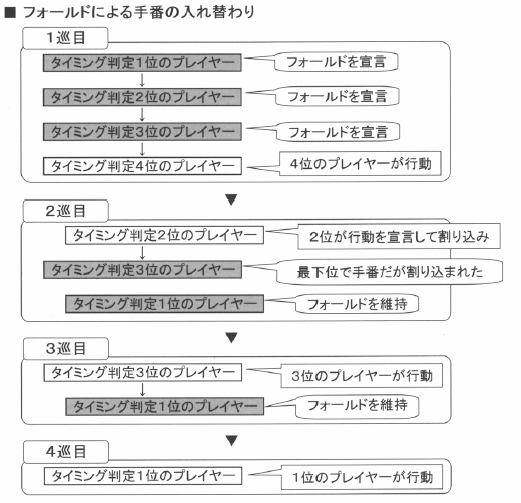
With that sorted, it's time for some COMBAT RULES

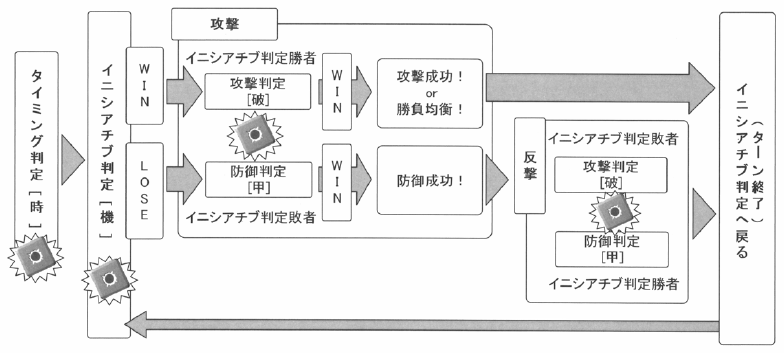
Holy shit that sure is a flowchart. Let's break it down:
1. Roll Timing and act in Timing Order! Pick your target and begin an attack.
2. Roll opposed Quick against their mech! Whoever wins gets to make an attack.
3. If the attacker wins the attack roll, then they deal damage.
4. If the attacker loses, then the defender can counter with an attack of their own.
5. If, after all this, neither combatant is at zero armor, go back to step 2 and repeat until somebody explodes.
To make an attack, the attacker rolls Break against the defender's Armor. If the attacker gets more 1's than the defender, then the amount of 1's they won by, multiplied by the attacker's Break, is the damage inflicted, and the defender's Armor is reduced by that much. To put this into perspective, the sample character, Prosecutor J, has 8 Break and 11 Armor. If you win by more than a single 1, then this is probably going to be an instant kill.
Attack rolls actually don't consider any numbers above 1 in the roll, so ties are possible. If you tie, then the attacker inflicts chip damage on the defender, equal to the number of 1's they rolled. If the defender wins, thetn they inflict chip damage back on the defender equal to the numer of 1's the attacker rolled. Then, the defender can counterattack! Run through the same process again, with attacker and defender reversed. After this, the battle ends - no option to do a second counterattack if the defender wins in the counterattach phase.
Anyway, that's the general flow for combat between Giant Allege. However, in most battles, not everyone willl have Alleges deployed. People combt is a little different!
For direct battles between Lawyers, everyone involved rolls to determine their Fighting Strength - the actual roll depends on their weapon (gun, fist or sword) as described in the last post. This roll is used for the previously-described surprise attacks that let you force an opponent to switch camps or reduce their stats or swap Giant Alleges. If you beat someone in a non-surprise mano-a-mano battle, then you inflict damage on them equal to the number of 1's you rolled, which reduces their Fighting Strength accordingly. If Fighting Strength reaches 0, then you can't continue fighting.
A Lawyer fighting on foot against an Allege is something that is generally only done in emergencies. These fights work approximately the same way as Allege vs Allege fights, except the Lawyer uses Fighting Strength in place of both Break and Armor. Whether the Lawyer succeeds at offense or defense, the damage they inflict is never more than the number of 1's they rolled.
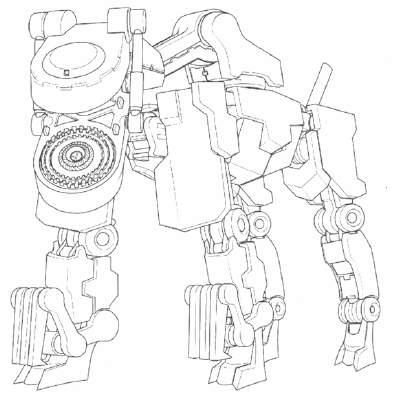
This is a picture of a Giant Allege named Mash Cerberus. Next time, we get to the list of Allege frames and equipment as we rapidly approach the end of the book.
Clients Dig Giant Robots
Original SA post
Giant Allege Part 7: Clients Dig Giant Robots
Mecha!
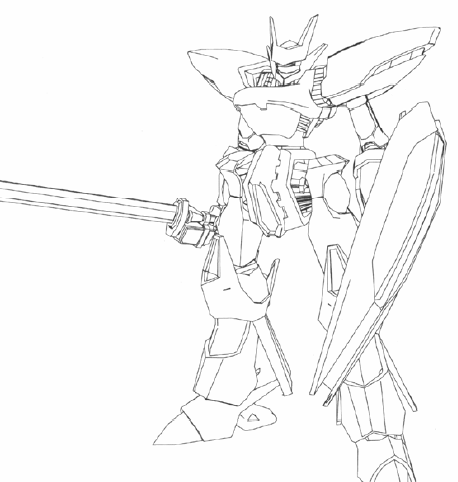
A mech is defined by a Form and two Armaments (ARM). All of these are rolled randomly on tables. Starting with the Forms, there are 11; roll two dice, and determine your choice based on the value of the first die (123 or 456) and the second die (1, 2, 3, 4, 5 or 6). If you roll 456-6, then you get to pick one freely.
The above is the first Form, number 123-1, Swordman . The most common type of Giant Allege on Gear's Rock. Specializing in sword combat, this Form gives you the option to select the ARM "One Sword, One Blow" as one of your two ARM slots before you randomly select.
I'm actually not going to post pictures for all of the Forms. Not because they're less than fantastic, but because I want to maintain some motivation for you folks to actually buy the PDF if you really like it.
Form 123-2 is the mighty Armorman , an unassailable fortress of absolute defense. If you get the Armorman Form, then you can choose to equip either "Absolute Shield" or "Armor Curtain" in one of your ARM slots before randomizing equipment.
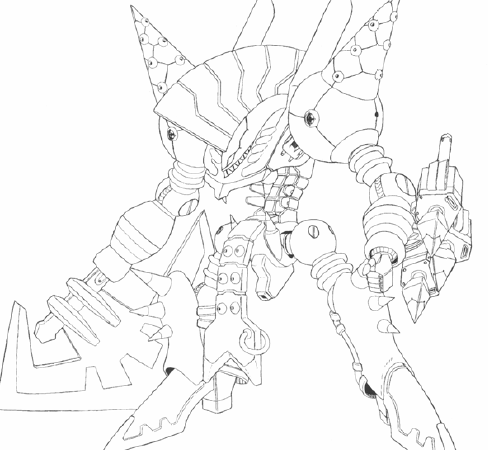
Form 123-3, the Barbarian is a totally radical and violent Allege Form dedicated to trying to wipe out the enemy in a single blow. Continuing in the trend of equipment-based Forms, this robo-mohawk-sporting Allege lets you select either "Axe Bomber" or "Peerless Spear" as one of your ARM slots before randomizing equipment.
Form 123-4, the Pankration is a massively strong Allege Form that requires no weapons of its own, fighting instead with absurdly huge fists. It can select "Do Through", "Hand Red Arm", or "Joint Break" as an ARM before randomizing equipment.
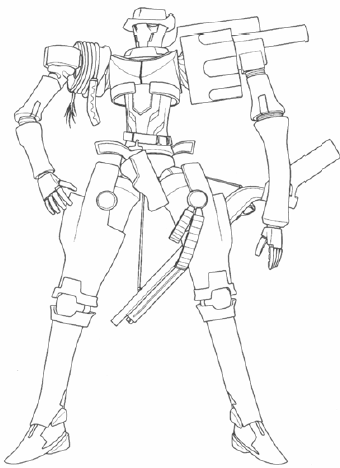
Holding the title of Probably the Stupidest-Looking Form, 123-5, the Gunman is a long-range fighting quick-draw Form. Same game as the last four, selectable ARMs are "Lightning Speed" and "Bullet of Light".
Last of the equipment-based Forms, the 123-6 Ballista is an absurd mech covered in guns from head to toe. This long-range bombardment type mech can provide either "Seaside Reach" or "Missile Shower" as its ARM.
Which brings us into the more functionally interesting Forms, the ones that actually have different stats! Starting with 456-1, the Trooper is a centaur-shaped Form with a lance for a hand. It gets a +1 bonus to Initiative roll results, but a -1 penalty to Defense roll results.
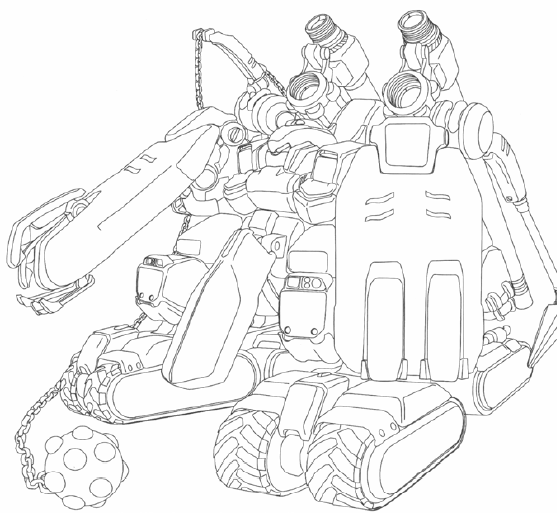
I said that the Ballista was absurd and covered in weaponry, but it's downright tame compared to 456-2, the Tank . Huge, clunky and invincible, the Tank gets -1 to Initiative, but +1 to both Attack and Defense roll results.
As we move into even less humanoid mechs, 456-3, the Beast , is shaped like a giant robot dog covered in improbable swords. A truly primal four-legged beast mech, this Form grants +5 to base Quick and Break, but forbids all equipment.
In the same category as Justice the Giant Allege, 456-4, the Harpy is the only flying Allege Form. Lightning quick but light, the Harpy gets +5 base Quick, but it can't be made with a Cost over 10.
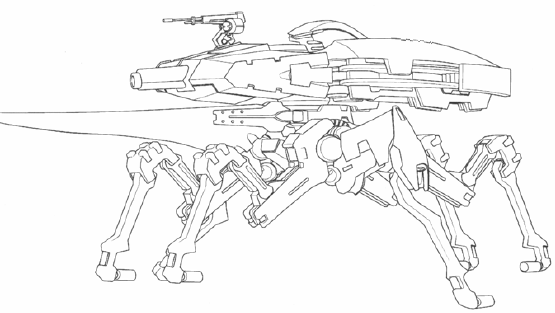
Last on the list, the 456-5, the Insect is about as far removed from humanoid mecha as we're going to get. It's much sturdier than that design makes it look, getting a +5 bonus to Armor, but can only equip one ARM.
Once the Form has been selected, it's time to randomly generate all undetermined ARMs! That's two slots, minus any slots either filled by special options from the Form or flat-out removed by the Form. For each, roll 2d6 and consult yet another huge list. Each grants a special ability and comes with a snappy(?) one-liner.
1-1: Lightning Speed. As available to the Gunman. This can be triggered only once. When activating, you automatically win your next initiative contest. If two people use it at the same time, they attack simultaneously.
"Just like a flash of lightning. Too fast for any eye to follow."
1-2: Drill Do Rill. One-off item activated before rolling Initiative. Any Attack rolls you make this turn have their results doubled.
"People who say that a drill is a man's romance have no faith in themselves. Why don't you go out and show 'em how it's done?"
1-3: Howling Ring. One-off item activated before rolling Initiative. Automatically win Initiative, deal 2 damage to the enemy's Quick, and immediately end the turn.
"It's bad luck to fire it off as a recital. Did you know that speakers can be lethal weapons?"
1-4: Do Through. As available to the Pankration. One-off item activated before rolling Initiative. This turn, apply your attack roll result directly to your enemy's Base Armor.
"Here, adjust the direction of your power a bit. The bigger they are, the harder they fall, right?"
1-5: Tornado Vortex. Can be used twice instead of once. After initiative, subtract your attack roll result from the enemy's base Quick.
"There are none standing on this Earth who can defeat this Soldier of Fortune!"
1-6: Queen's Whip. Two uses again, activated before rolling Initiative. This turn, any damage you do affects the enemy's Quick instead of their Armor.
"All men are masochists. No matter how they show off, their breath goes wild once they're under my heel."
2-1: Smoke Mock. Two uses, activated before rolling Initiative. Reduce your opponent's Initiative dice pool to half, rounded up.
"Just because this smoke rises doesn't mean there's a fire."
2-2: Hammer Price. One use, activated before rolling Initiative. If you win Initiative, your final damage roll is set to your current Break.
"If you've got time to think, then you've got time to settle everything in a single blow."
2-3: Missile Shower. As available to the Ballista. Two uses, activated before rolling Initiative. If you win Initiative, then roll 10 additional dice on your attack.
"If they're good at dodging, give them no place to dodge to. There isn't anyone who can stay dry in the rain, right?"
2-4: Sticky Net. Two uses, activated before rolling Initiative. Your opponent rolls five fewer Initiative dice.
"Eww, what the heck?! It's gross to get covered in sticky white fluid!"
2-5: Reverse Solar Generator Beam. One use, activated before rolling Initiative. If you win Initiative, your final damage roll is set to your base Break (before adding pilot stats).
"I'll stop you with all my heart! My Allege's soul is on fiiiire!"
2-6: Seaside Reach. As available to the Ballista. Two uses, activated before rolling Initiative. This turn, you can't be Counterattacked.
"What's that? There's no way to strike from the far side of the ocean? Sorry, but this kid is special."
3-1: Accelerator. Two uses, activated AFTER rolling Initiative. Add one to your final Initiative result.
"Speed is all about equipment, you say? Try giving this baby a ride. I'll scrape you off the cockpit afterwards."
3-2: Redo Motion. Two uses, activated after rolling Initiative. Your opponent rerolls their Initiative, and can't use any Initiative-altering ARMs this time.
"It's a complete do-over... but only for you."
3-3: Flash Grenade. Two uses, activated after rolling Initiative. You reroll your Initiative.
"Are you ready? This is my ultimate attack! Keep those eyes peeled so that you can witness its glory!"
3-4: Diving Earth. Two uses, activated after rolling Initiative. The turn ends immediately.
"Oho, it's rare to find people who sprout from the earth."
3-5: Joint Break. As available to the Pankration. One use, activated before rolling attack. This turn, your damage is inflicted on the enemy's Break.
"I live for the sound of my opponent's call for surrender."
3-6: Melting Acid. One use, activated before rolling attack. Instead of rolling for damage, you reduce the enemy's Armor by half.
4-1: Hand Red Arm. One use, activated before rolling Initiative. If you win Initiative, then your attack's damage reduces the enemy's Quick, Break, AND Armor.
"Oraoraoraoraoraoraoraora... and one more for the road!"
4-2: Bullet of Light. As available to the Gunman. Two uses, activated before rolling attack. Instead of rolling, your attack roll is set to 4.
"Oh, this is no good. I was aiming for a counter attack, but that's not going to be possible."
4-3: Never Ending. One use, activated before rolling attack. Don't roll attack this turn. Instead, restore all attributes to their maximum values. The enemy can't counter.
"There it is! That's the face I wanted to see! Kyahahahahaha! This party's just getting starteeeed!"
4-4: Power Charge. Two uses, activated before rolling attack. Don't roll, and instead roll double dice next turn. This turn, the enemy can't counter.
"Don't be so impatient. The ideal path is to understand that Process is Success!"
4-5: One Sword, One Blow. As available to the Swordman. Two uses, activated before rolling attack. Double your attack dice.
"A sword has dreams, hopes, and will of its own."
4-6: Peerless Spear. As available to the Barbarian. Two uses, activated before rolling attack. Add to to your attack roll result.
"This tip of this spear can cut a flying crow in half. That's why it's called Crow Cutter. Can you believe it?!"
5-1: Thunder Wall Break. One use, activated before rolling attack. Roll attack dice equal to your team's Budget.
"He turns every enemy he points at into ashes. There's no running away from this."
5-2: Perfect Foresight. Two uses, activated before rolling defense. Even if you fail your defense roll this turn, you can counter as if you succeeded.
"Trials begin and end with receiving and countering your opponent's arguments. Let me show it to you know: The Windmill Hypothesis!"
5-3: Axe Bomber. As available to the Barbarian. One use, before rolling attack. Double the final result of your attack roll.
"If I cut their body deeply enough, they'll explode. That's what it means to be number one in power."
5-4: Greek Fire. Two uses, activated AFTER rolling attack. Set your attack roll to 3. The enemy can't defend.
"Of course, this won't pierce the defenses of every Allege, but against a human, it's unstoppable."
5-5: Photonic Barrier. Two uses, activated before rolling defense. Set your defense roll result to 4.
"Such an attack won't be able to break through my photonic barrier. Wh-What's this? My barrier... is falling apart?!"
5-6: Armor Curtain. As available to the Armorman. One use, activated before rolling defense. Your defense roll automatically succeeds, but you can't counter.
"Whatever villainous legal attack I must endure, this armor curtain will weather it for three days and nights!"
6-1: Perfect Shield. As available to the Armorman. One use, activated after rolling defense. Double your defense roll result.
"So you think your weapon can reach me? How adorable. It's my turn now..."
6-2: Heavy Low Tension. One use, activated before rolling Timing. Every roll in this battle is made with a maximum of ten dice.
"Too bad, but I'm already used to this!"
6-3: Sonic Low. Two uses, activated when dealing chip damage. Inflicted damage is set to 3.
"You're tryig to stop a monster. Did you think you could come out unharmed?"
6-4: Zero Range Battle Skill. Two uses, activated when an enemy uses an ARM. The ARM's activation is canceled, but the usage is not expended.
"True terror is fighting at range zero. None of your weapons will help you here."
6-5: Death Trap. One use, activated after your enemy successfully attacks. Next turn, you automatically win Initiative, and your attack is doubled that turn.
"How naive, child. Do you still believe that a trial can be won using skill and heart alone?"
6-6: Zombina System. One use, activated when you're defeated. Your Armor is set at 0, and you can continue to fight until you take damage again.
"If I lose here... then all your lies will become truth. That alone... That alone, I cannot stand for! UWOOOOOOOOH!"
And that's it! The entire 28-page rulebook. I don't have any particular closing words for this game, aside from that I'd like to play it at least once, so here's the back cover:
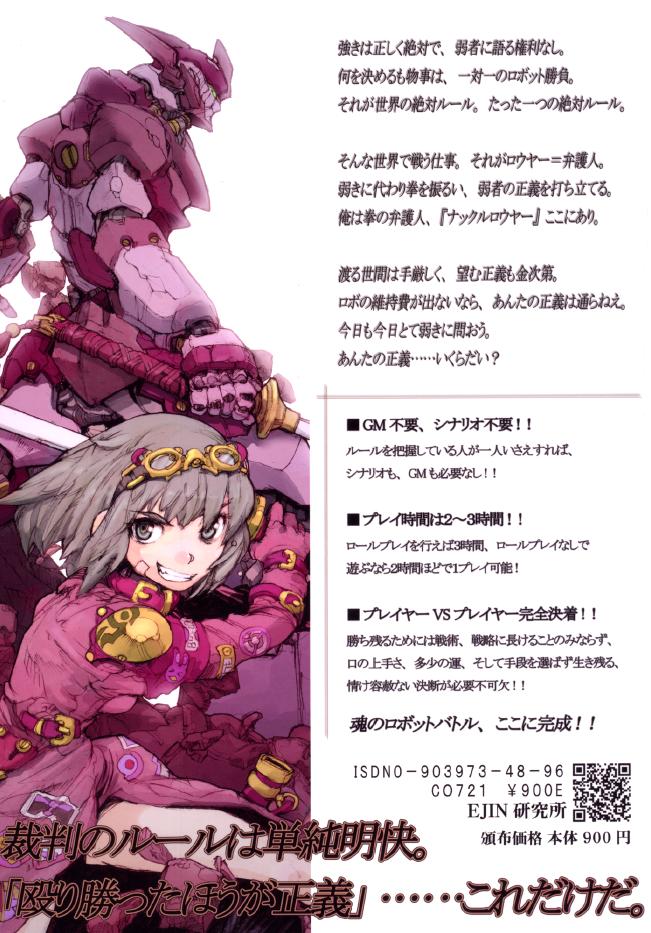
That was fun. I think I'll do Great Ork Gods next.